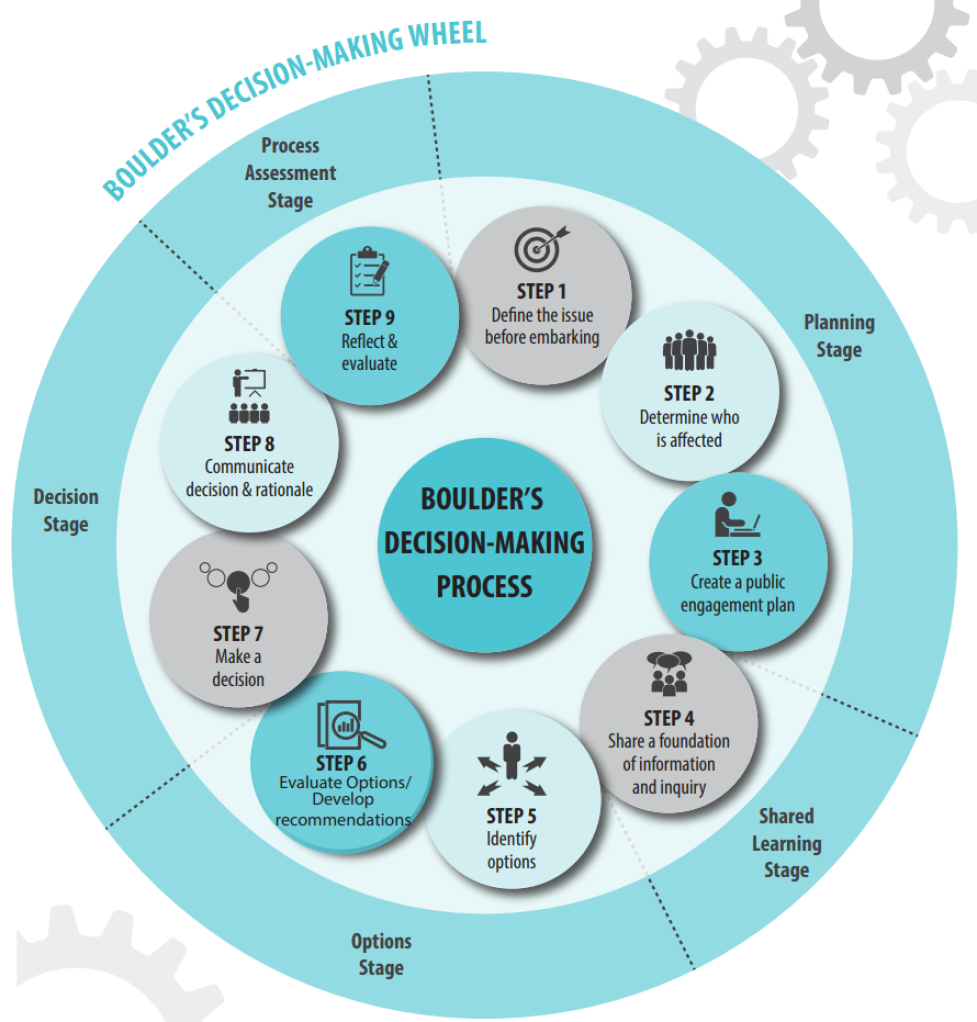The City’s Engagement Journey
Boulder’s journey toward more inclusive and consistent public engagement began in 2016, when City Council directed staff to work with the community to identify improvements. A 14-member Public Participation Working Group helped define key challenges, recommend solutions, and highlight the need to shift the city’s culture around engagement. Their work led to two main recommendations: adopt a comprehensive decision-making process and make public engagement a core city value.
In response, the city developed the Engagement Strategic Framework, approved in 2017, to guide more coordinated, equitable and transparent engagement practices. This commitment was further strengthened with the city’s Racial Equity Plan, adopted in 2021, which outlines strategies to build trust and expand the influence of communities of color through responsive and inclusive engagement.
The City of Boulder is continually strengthening our engagement culture and processes because we recognize that local government makes better decisions and creates more responsive programs and services when the community we serve has a meaningful voice.
The best community engagement is appropriately scaled, consistent and reliable, transparent, equitable and inclusive for all participants.
Boulder’s Engagement Spectrum
The city’s engagement spectrum, adapted from IAP2 and Facilitating Power, identifies and clarifies the appropriately scaled role of community in project planning and decision-making processes. Each engagement process is customized and appropriately scaled.
| Level | Description | Promise |
|---|
| Inform | Provides communities and stakeholders accurate, balanced and accessible information on the problem, alternatives and/or solutions. | We will keep the community and stakeholders informed. |
|---|
| Consult | Seeks feedback on the problem, alternatives, and/or solutions. | We will consider community and stakeholder feedback and communicate how the feedback influenced the decision. |
|---|
| Involve | Seeks to understand community and stakeholder concerns and aspirations to influence the decision-making process. | We will use community and stakeholder input in the decision-making process and communicate how the feedback influenced the decision. |
|---|
| Collaborate | Shares responsibility for decision-making with the community and stakeholders. | We will co-create solutions and make decisions with the community and stakeholders. |
|---|
City of Boulder's Decision-Making Process
Center Label:
“Boulder’s Decision-Making Process.”
The nine steps, in order (clockwise from top):
- Step 1 (Planning Stage): Define the issue before embarking
- Step 2 (Planning Stage): Determine who is affected
- Step 3 (Planning Stage): Create a public engagement plan
- Step 4 (Shared Learning Stage): Share a foundation of information and inquiry
- Step 5 (Options Stage): Identify options
- Step 6 (Options Stage): Evaluate options / Develop recommendations
- Step 7 (Decision Stage): Make a decision
- Step 8 (Decision Stage): Communicate decision and rationale
- Step 9 (Process Assessment Stage): Reflect and evaluate
Each stage is labeled in the outer circle surrounding the central process.
The process is visualized as a wheel to emphasize that it is continuous and iterative.
Strategies for Success
As the city works toward culture change, it has identified seven strategies that will serve as focus areas:
Learn Together
Build skills and a shared understanding of core principles, practices and processes associated with high-quality community engagement.
Help People Know What to Expect
Implement consistent processes to support the creation and use of effective and appropriately scaled engagement plans. Communicate clearly about opportunities for timely and meaningful public input and engagement.
Cultivate Respectful Relationships
Build and strengthen relationships with those affected by city decisions and programs through constructive dialogue. Pilot new approaches to invite and encourage all impacted individuals and groups to participate in ways that are welcoming to them.
Be Transparent
Develop and implement techniques that increase transparency into decision-making and democratic processes. Help everyone understand constraints and the variety of perspectives on any given issues and explain how the feedback received shaped the outcome.
Use the Right Tools
Assess our current and existing engagement tools and techniques and choose those that most effectively allow us to reach desired audiences.
Evaluate and Evolve
Demonstrated a commitment to innovation and continuous improvement through honest evaluation of clearly defined metrics as well as ongoing creativity in the pursuit of new ideas.
Equitably Engage
Co-design multiculturally proficient and multilingual engagement processes that center historically excluded communities. Reduce barriers and build capacity of historically excluded communities to participate in engagement opportunities.
